Experimental Investigation of Reinforced Concrete Beam with Openings Strengthened Using FRP Sheets under Cyclic Load
Abstract
1. Introduction
2. Experimental Program
2.1. Specimen Details and Parameters
2.2. Preparation of Specimens and CFRP Installation
2.3. Material Properties
2.4. Setup of Test Models
3. Experimental Results and Discussion
3.1. Failure Mode and Crack Patterns
3.2. Hysteretic Behavior
3.3. Secant Stiffness and Strength Degradation
3.4. Absorption and Energy Dissipation
4. FEM
4.1. Model Geometry and Mesh
4.2. Material Model
4.3. Loading and Boundary Condition
4.4. Failure Model
5. Verification of Numerical Modelling
6. Parametric Study
6.1. Effect of FRP Sheet Length
6.2. Effect of Opening Diameter
7. Conclusions
- The results of the experiments and numerical simulations clearly show that beam capacity, stiffness degradation, energy absorption and failure mode of failure are significantly influenced by the openings located in the shear zone or flexural zone. The effectiveness of FRP strengthening in restoring the original capacity of the beam is confirmed. The similarity and good convergence between the experimental data and those from FE simulations prove that the identified model parameters are accurate, sensitive and acceptable in evaluating the strength and stiffness of beams with web openings. The effectiveness of FRP strengthening is verified, thereby demonstrating the feasibility of FEM in future research.
- For the beam with an opening in the shear zone, the FRP sheet succeeds in improving the total strength by approximately 66.69%, which is considered the average result for the two orientations. In the flexural zone, the enhancement reaches 74.84% compared with the equivalent control beam, and the energy absorption increases by approximately 64.87% and 77.14%. Thus, the opening in the shear zone results in a remarkable decrease in the strength and stiffness failure of loads. A good correlation is obtained in the numerical and experimental results of hysteretic response, maximum load and damage mode, with an average correlation ratio of 90%.
- The circular web openings for the two zones (bending and shear) of RC beams under cyclic loading can be categorized as small, large and very large on the basis of the d/D ratio in accordance with the classification conducted by Mansur [3], where d/D < 40% for small type and d/D > 50% for large type openings. The numerical simulation indicates that the recommended ratios of d/D < 40 as small, 0.4 < d/D < 0.6 as large and d/D > 0.6 as very large. This classification is in close agreement with the rectangular opening in the shear zone conducted by [23].
- For small circular openings in the (shear/bending) zones of RC beams, the effect of opening size represents loss of strength, stiffness and energy absorption. The opening is remarkably smaller and within the appropriate range compared with that of solid beams. In this case, strengthening may be not needed. For large opening beams, FRP strengthening may be extremely important and used to restore the losses in beam capacity either fully or partially. The proposed increased bond length of two layers of FRP sheet (equivalent 2d) was used in this study and successfully restored the maximum load and energy absorption by approximately 77.5% and 65%, respectively, for the beam with an opening in the bending zone and by approximately 73% and 64% for the beam with an opening in the shear zone. For the very large opening, the external bonding of FRP is ineffective in restoring the original beam strength because of premature failure compression.
Author Contributions
Funding
Conflicts of Interest
References
- Ahmed, A.; Fayyadh, M.M.; Naganathan; Nasharuddin, K. Reinforced concrete beams with web openings: A state of the art review. Mater. Des. 2012, 40, 90–102. [Google Scholar] [CrossRef]
- Mansur, M.A.; Huang, L.M.; Tan, K.H.; Lee, S.L. Deflections of reinforced concrete beams with web openings. ACI Struct. J. 1992, 89, 391–397. [Google Scholar]
- Mansur, M.A. Design of reinforced concrete beams with web opengs. In Proceedings of the Asia-Pacific Software Engineering Conference (APSEC), Bangalore, India, 6–8 December 2006; pp. 104–120. [Google Scholar]
- ACI 318-08. In Building Code Requirements for Structural Concrete; American Concrete Institute: Farmington Hills, MI, USA, 2008; Volume 11, pp. 171–183.
- Aykac, B.; Kalkan, I.; Aykac, S.; Egriboz, Y.E. Flexural behavior of RC beams with regular square or circular web openings. Eng. Struct. 2013, 56, 2165–2174. [Google Scholar] [CrossRef]
- Mansur, M.A.; Tan, K.H.; Lee, S. Collapse Loads of R/C Beams with Large Openings. J. Struct. Eng. 2008, 110, 2602–2618. [Google Scholar] [CrossRef]
- Thanasis, C.T. Shear Strengthening of Reinforced Concrete Beams UsingEpoxy-Bonded FRP Composites. ACI Struct. J. 1998, 95, 107–115. [Google Scholar]
- Osman, B.H.; Wu, E.; Ji, B.; Abdelgader, A.M.S. A state of the art review on reinforced concrete beams with openings retrofitted with FRP. Int. J. Adv. Struct. Eng. 2016, 8, 253–267. [Google Scholar] [CrossRef]
- Anil, Ö. Improving shear capacity of RC T-beams using CFRP composites subjected to cyclic load. Cem. Concr. Compos. 2006, 28, 638–649. [Google Scholar] [CrossRef]
- Täljsten, B. Strengthening concrete beams for shear with CFRP sheets. Constr. Build. Mater. 2003, 17, 15–26. [Google Scholar] [CrossRef]
- Abdalla, H.A. Design against cracking at openings in reinforced concrete beams strengthened with composite sheets. Compos. Struct. 2003, 60, 197–204. [Google Scholar] [CrossRef]
- Pimanmas, A. Strengthening R/C beams with opening by externally installed FRP rods: Behavior and analysis. Compos. Struct. 2010, 92, 1957–1976. [Google Scholar] [CrossRef]
- Maaddawy, T.E.; Sherif, S. FRP composites for shear strengthening of reinforced concrete deep beams with openings. Compos. Struct. 2009, 89, 60–69. [Google Scholar] [CrossRef]
- Osman, B.H.; Wu, E.; Ji, B.; Abdulhameed, S.S. Repair of Pre-cracked Reinforced Concrete (RC) Beams with Openings Strengthened Using FRP Sheets Under Sustained Load. Int. J. Concr. Struct. Mater. 2017, 11, 171–183. [Google Scholar] [CrossRef]
- Shoeib, A.E.; Sedawy, A.E. Shear strength reduction due to introduced opening in loaded RC beams. J. Build. Eng. 2017, 13, 28–40. [Google Scholar] [CrossRef]
- Salama, A.E.; Kassem, M.E.; Mahmoud, A.A. Torsional behavior of T- shaped reinforced concrete beams with large web openings. J. Build. Eng. 2018, 18, 84–94. [Google Scholar] [CrossRef]
- Chin, S.C.; Shafiq, N.; Nuruddin, M.F. FRP as strengthening material for Reinforced Concrete beams with openings—A review. KSCE J. Civ. Eng. 2014, 19, 213–219. [Google Scholar] [CrossRef]
- Herrera, L.; Anacleto-Lupianez, S.; Lemnitzer, A. Experimental performance of RC moment frame beams with rectangular openings. Eng. Struct. 2017, 152, 149–167. [Google Scholar] [CrossRef]
- Osman, B.H.; Wu, E.; Bohai, J.; Abdallah, M. Repair technique of pre-cracked reinforced concrete (RC) beams with transverse openings strengthened with steel plate under sustained load. J. Adhes. Sci. Technol. 2017, 31, 2360–2379. [Google Scholar] [CrossRef]
- Elsayed, M.; Elsayed, A.; Snosy, Y. Behavior of RC Deep Beam with Web Openings Strengthened With Ferrocement Overlays. IOSR J. Mech. Civ. Eng. 2018, 15, 45–52. [Google Scholar]
- Hassan, N.Z.; Sherif, A.G.; Zamarawy, A.H. Finite element analysis of reinforced concrete beams with opening strengthened using FRP. Ain Shams Eng. J. 2017, 8, 531–537. [Google Scholar] [CrossRef]
- Nie, X.F.; Zhang, S.S.; Teng, J.G.; Chen, G.M. Experimental study on RC T-section beams with an FRP-strengthened web opening. Compos. Struct. 2018, 185, 273–285. [Google Scholar] [CrossRef]
- Elsanadedy, H.M.; Al-Salloum, Y.A.; Almusallam, T.H.; Alshenawy, A.O.; Abbas, H. Experimental and numerical study on FRP-upgraded RC beams with large rectangular web openings in shear zones. Constr. Build. Mater. 2019, 194, 322–343. [Google Scholar] [CrossRef]
- Abaqus/CAE User’s Manual; Dassault Systèmes: Vélizy-Villacoublay, France, 2012.
- Barbero, E.J. Introduction to Second Edition Compocite Materials Design; Taylor & Francis Group: New York, NY, USA, 2011. [Google Scholar]
- Setunge, S.; Kumar, A.; Nezamian, A.; De Silva, S.; Carse, A.; Spathonis, J.; Chandler, L.; Gilbert, D.; Johnson, B.; Jeary, A.; et al. Review of Strengthening Techniques Using Externally Bonded Fiber Reinforced Polymer Composite; CRC for Construction Innovation: Brisbane, Australia, 2002. [Google Scholar]
- ACI 440.2R-08. In Guide for the Design and Construction of Externally Bonded FRP Systems for Strengthening Existing Structures; American Concrete Institute: Farmington Hills, MI, USA, 2008.
- Materials, B. Strengthening of RC T-section beams with low strength concrete using CFRP composites subjected to cyclic load. Constr. Build. Mater. 2008, 22, 2355–2368. [Google Scholar]
- Tao, Y.; Chen, J.F. Concrete Damage Plasticity Model for Modeling FRP-to-Concrete Bond Behavior. J. Compos. Constr. 2014, 19, 04014026. [Google Scholar] [CrossRef]
- Park, R.; Paulay, T. Reinforced Concrete Structures. Cond. Assess. Aged Struct. 1975, 1, 1–769. [Google Scholar]
- Simulia, D.S. Theory Manual. Eur. Hqrs. 2012, 2, 1–117. [Google Scholar]
- Bahij, S.; Adekunle, S.K.; Al-Osta, M.; Ahmad, S.; Al-Dulaijan, S.U.; Rahman, M.K. Numerical investigation of the shear behaviour of reinforced ultra-high-performance concrete beams. Struct. Concr. 2018, 19, 305–317. [Google Scholar] [CrossRef]
- Lee, J.; Fenves, G.L. Plastic-Damage model for cyclic loading of concrete structures. J. Eng. Mech. 1998, 124, 892–900. [Google Scholar] [CrossRef]
- Altaee, M.; Cunningham, L.S.; Gillie, M. Practical Application of CFRP Strengthening to Steel Floor Beams with Web Openings: A numerical Investigation. J. Constr. Steel Res. 2019, 155, 395–408. [Google Scholar] [CrossRef]
- Barbato, M. Efficient finite element modeling of reinforced concrete beams retrofitted with fibre reinforced polymers. Comput Struct. 2009, 87, 167–176. [Google Scholar] [CrossRef]
- Lam, L.; Teng, J.G. Design-oriented stress—strain model for FRP-confined concrete. Constr. Build. Mater. 2003, 17, 471–489. [Google Scholar] [CrossRef]
- Khalifa, A.; Gold, W.J.; Nanni, A. Contribution of Externally Bonded FRP to Shear Capacity of Flexural Members. J. Compos. Constr. 1998, 2, 195–203. [Google Scholar] [CrossRef]
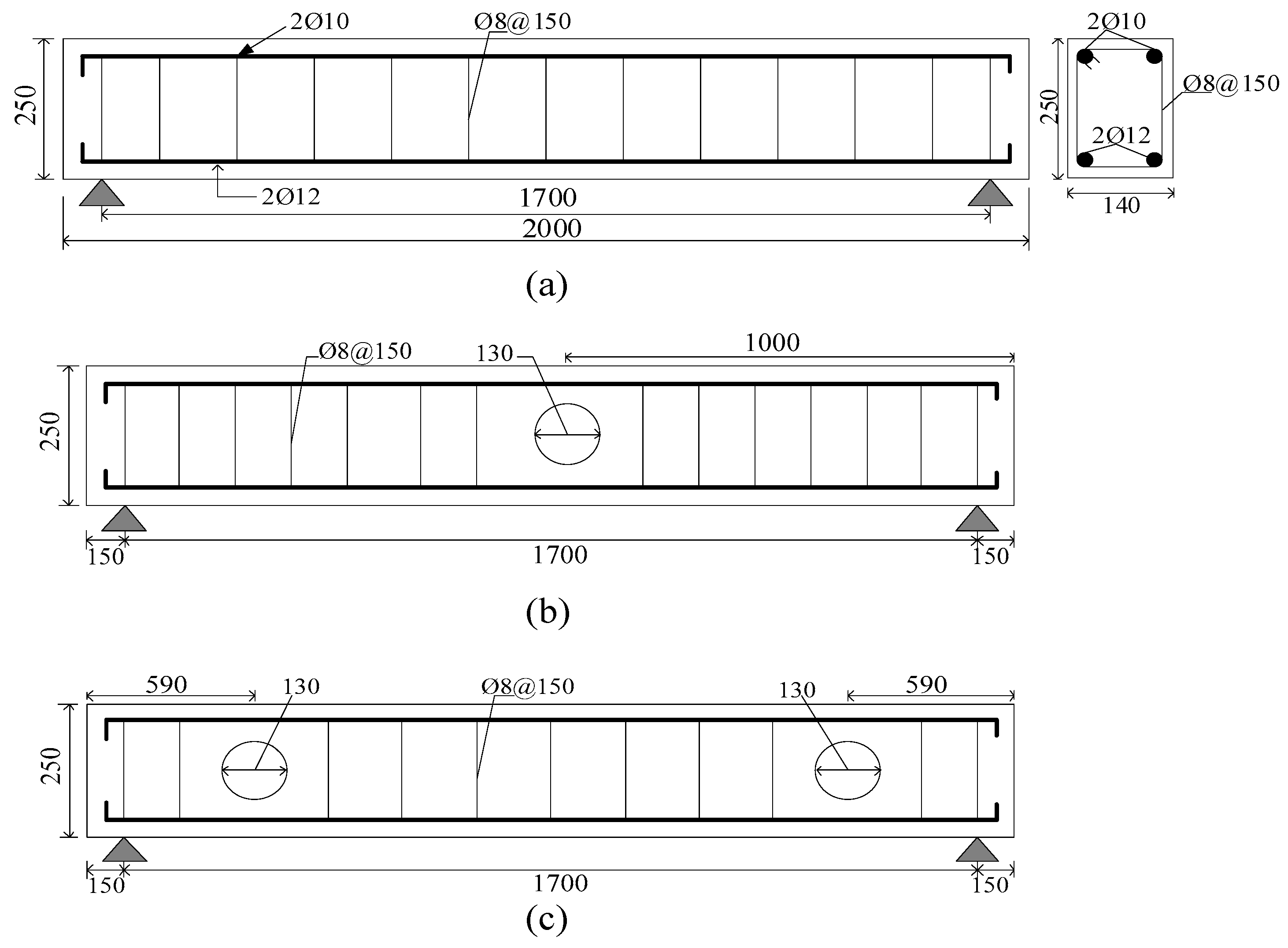
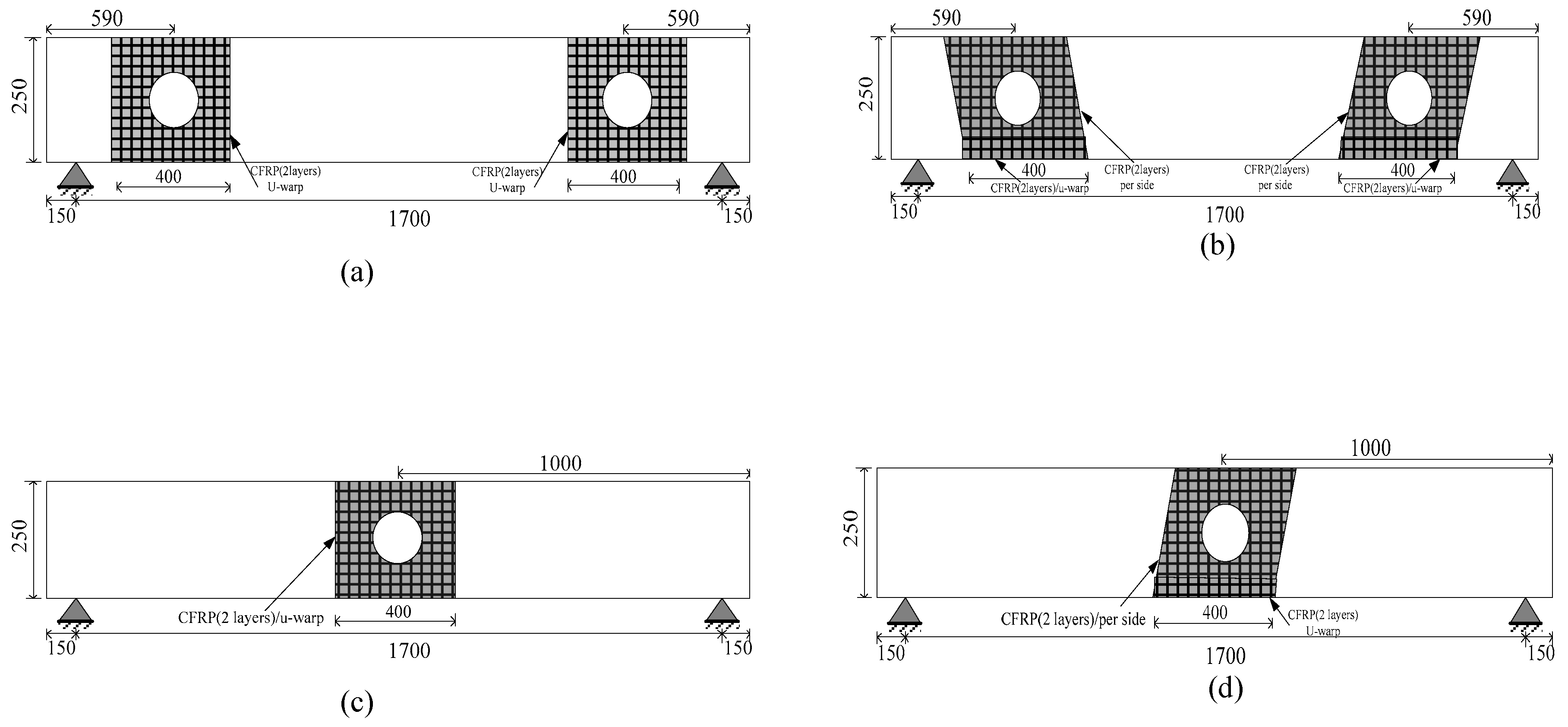

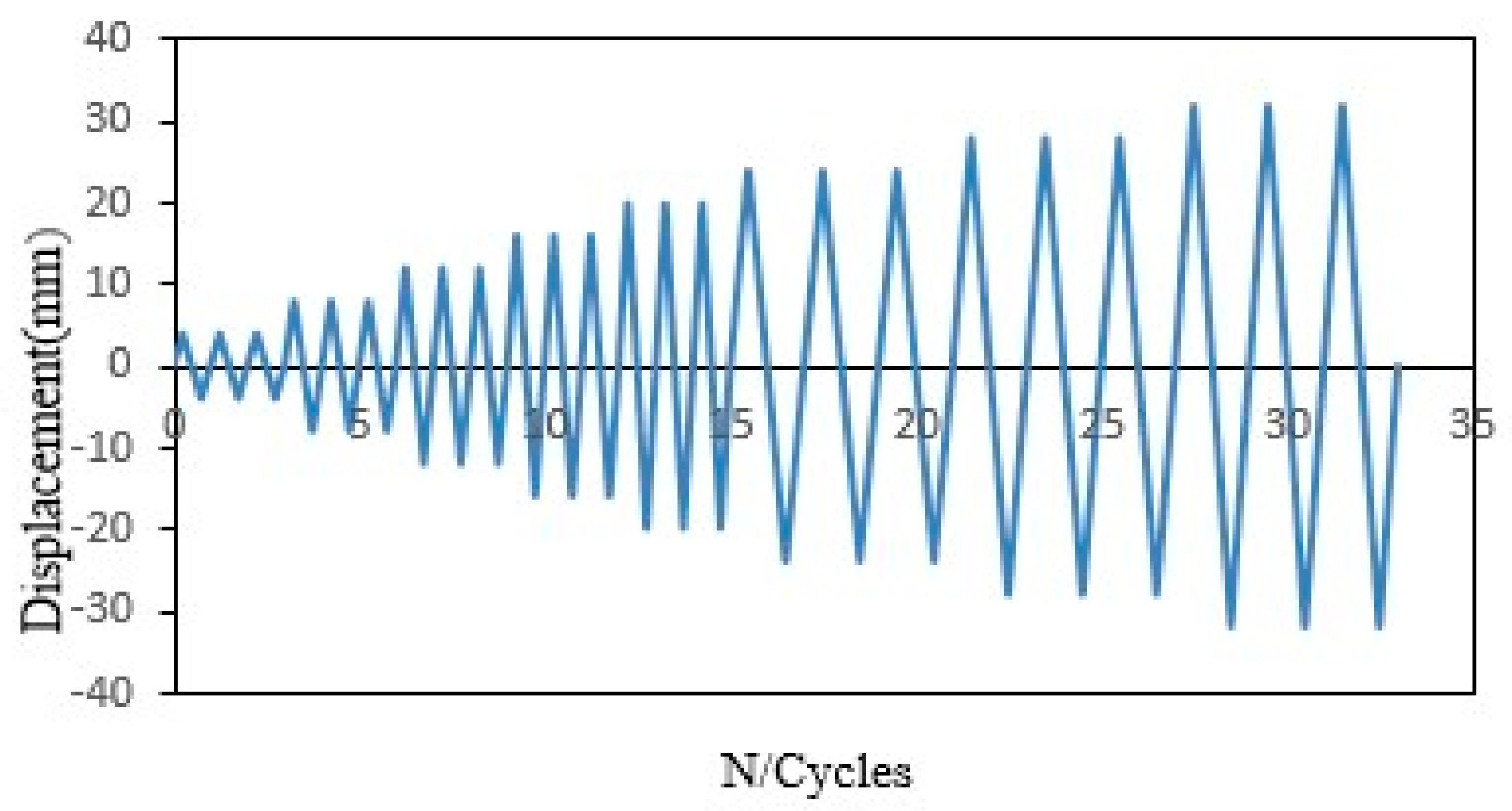
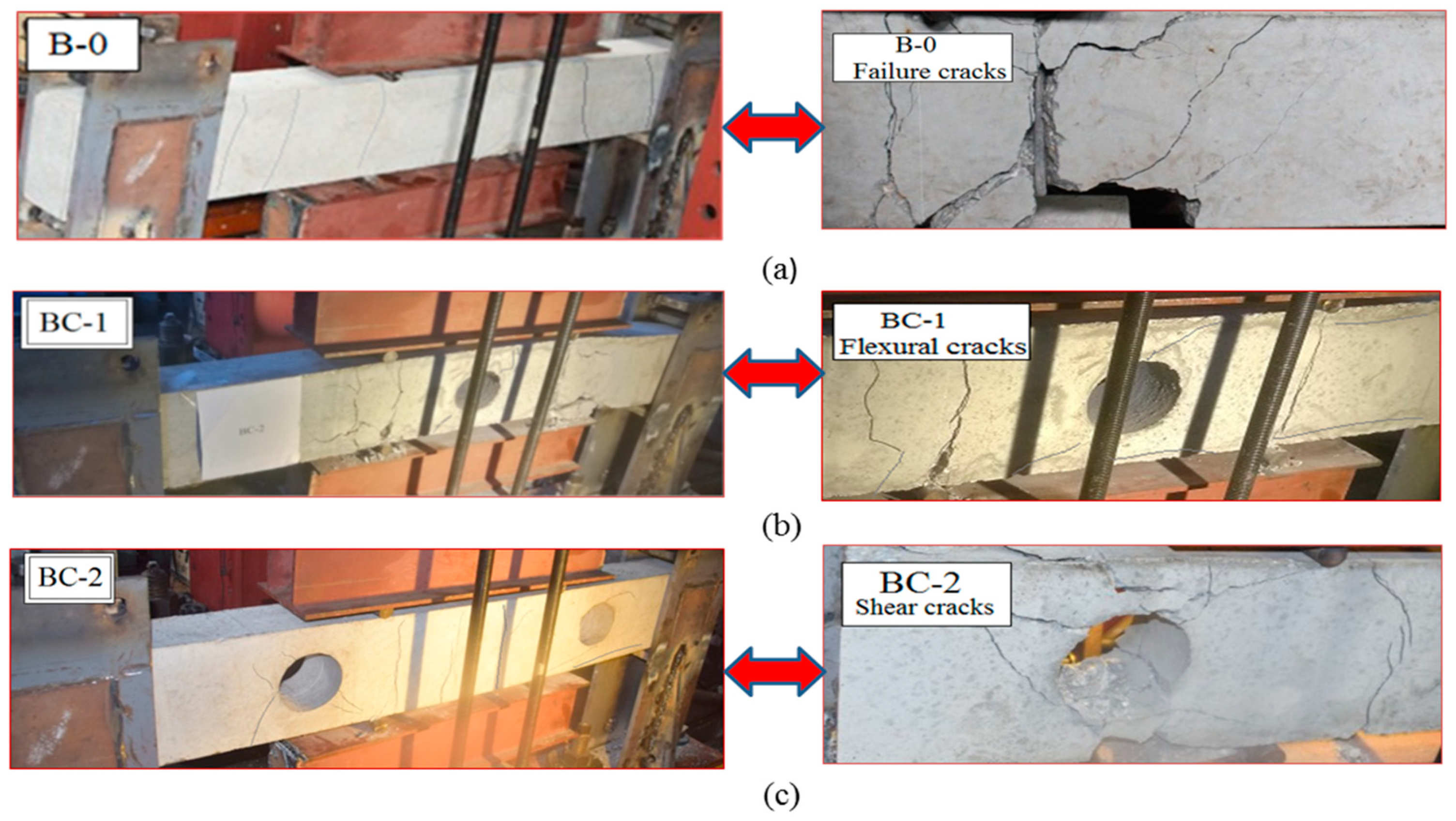
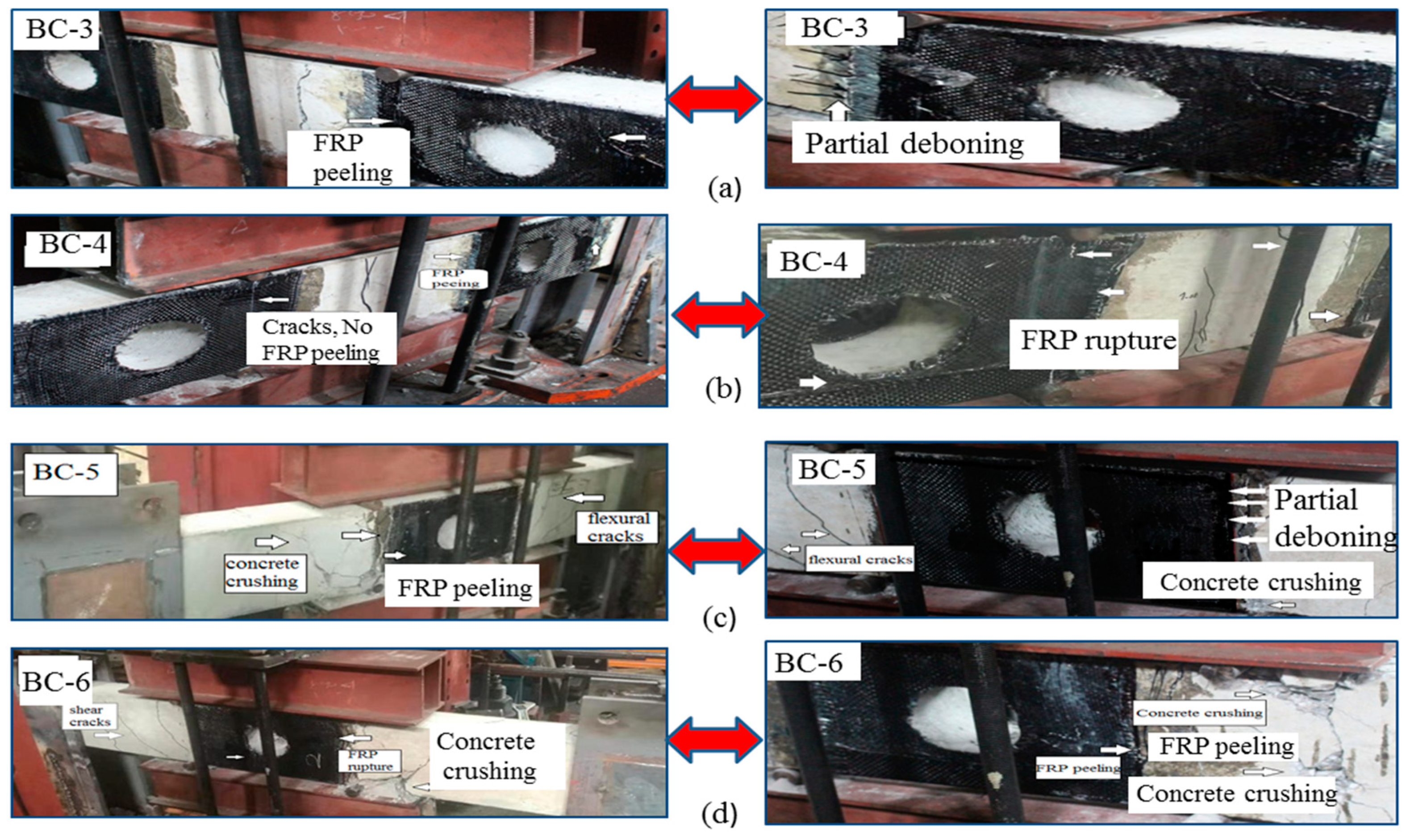

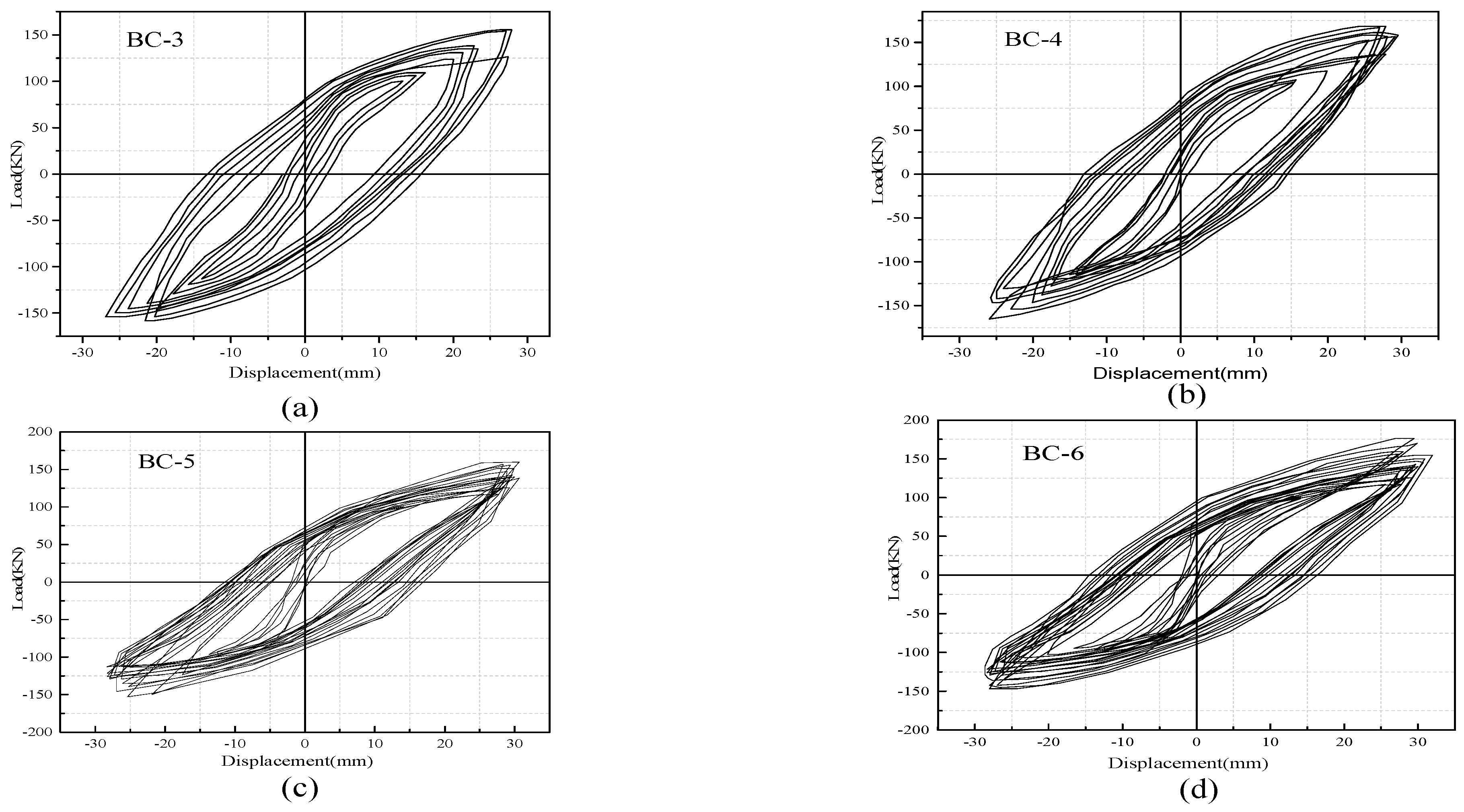
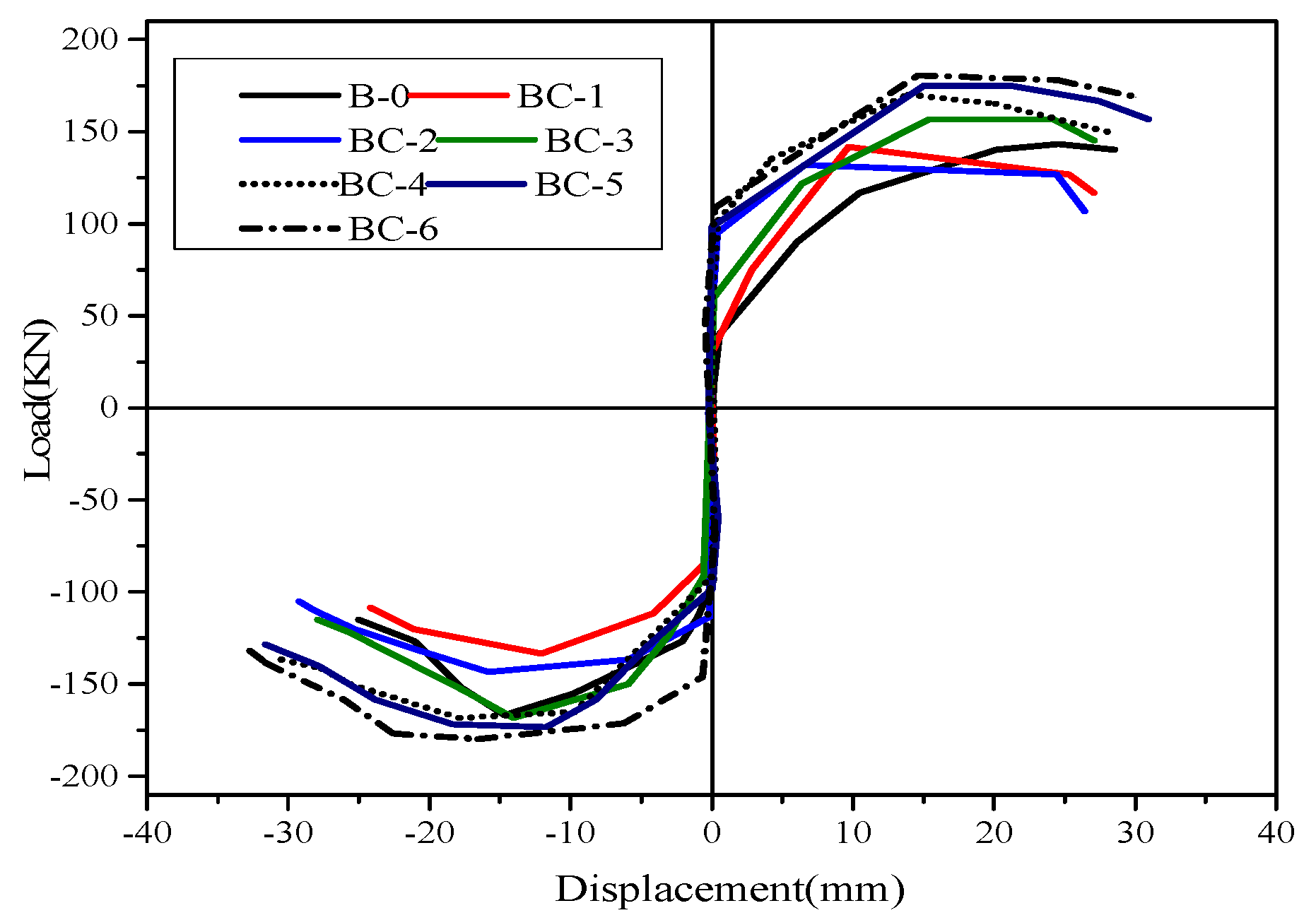
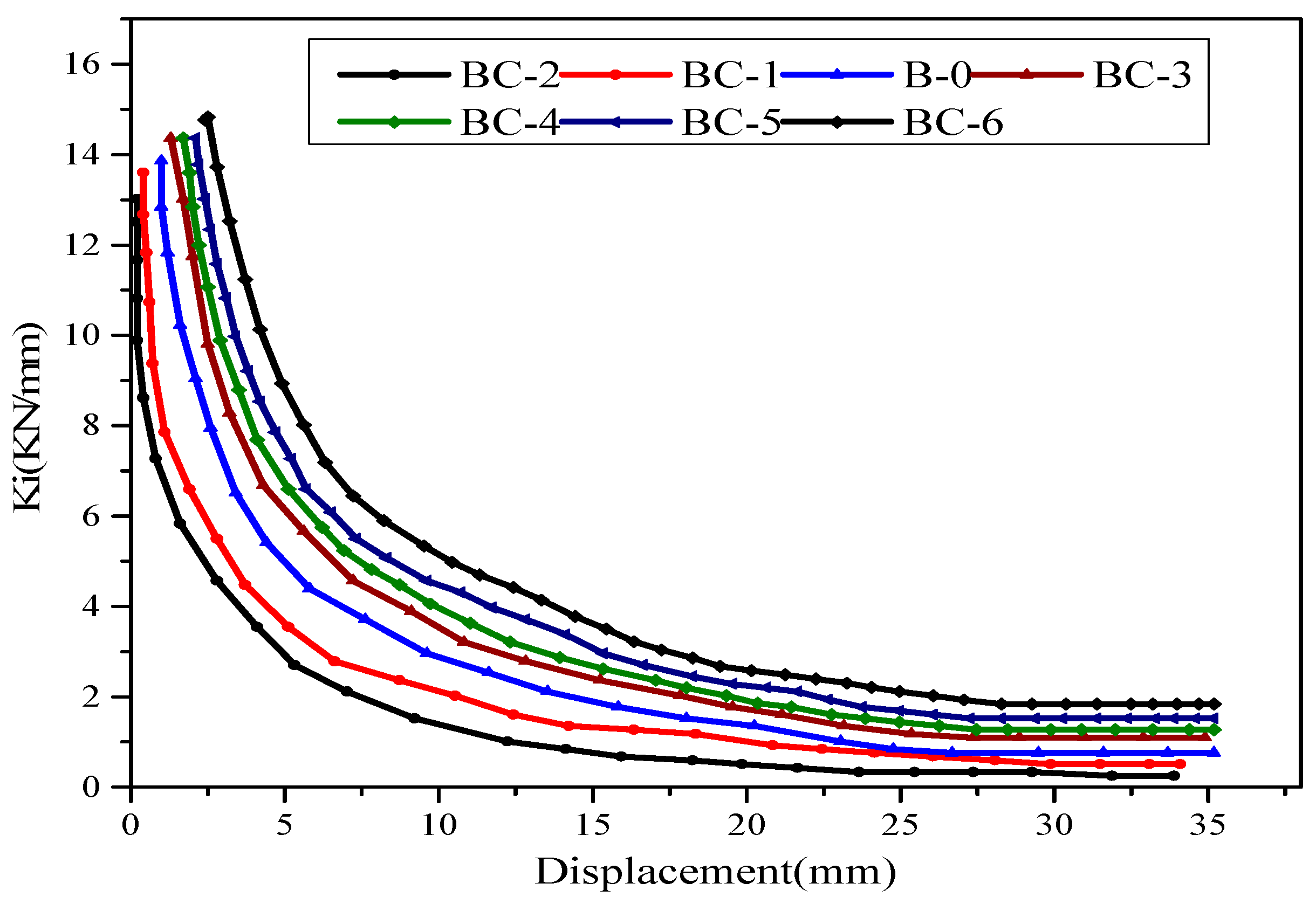


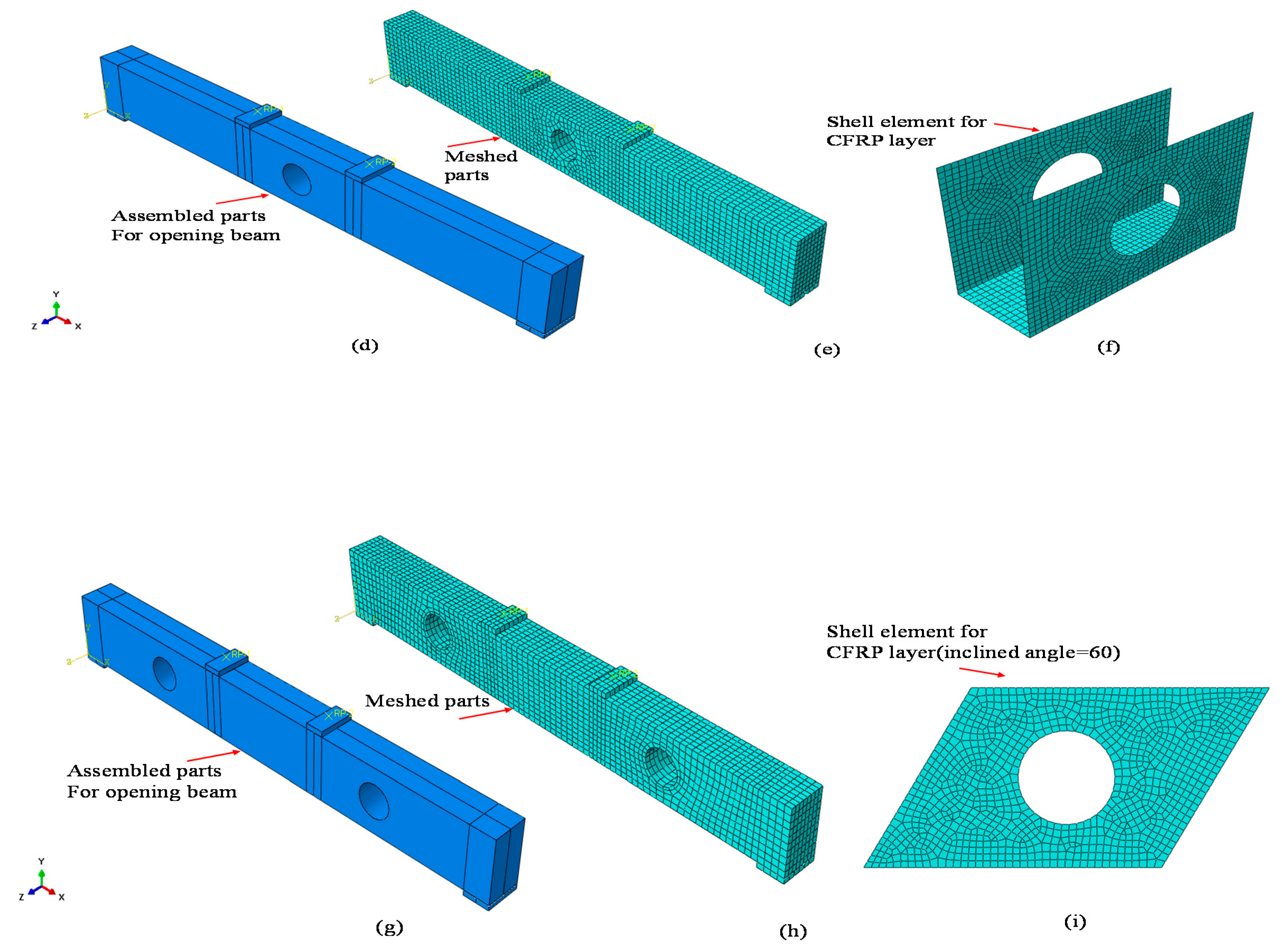
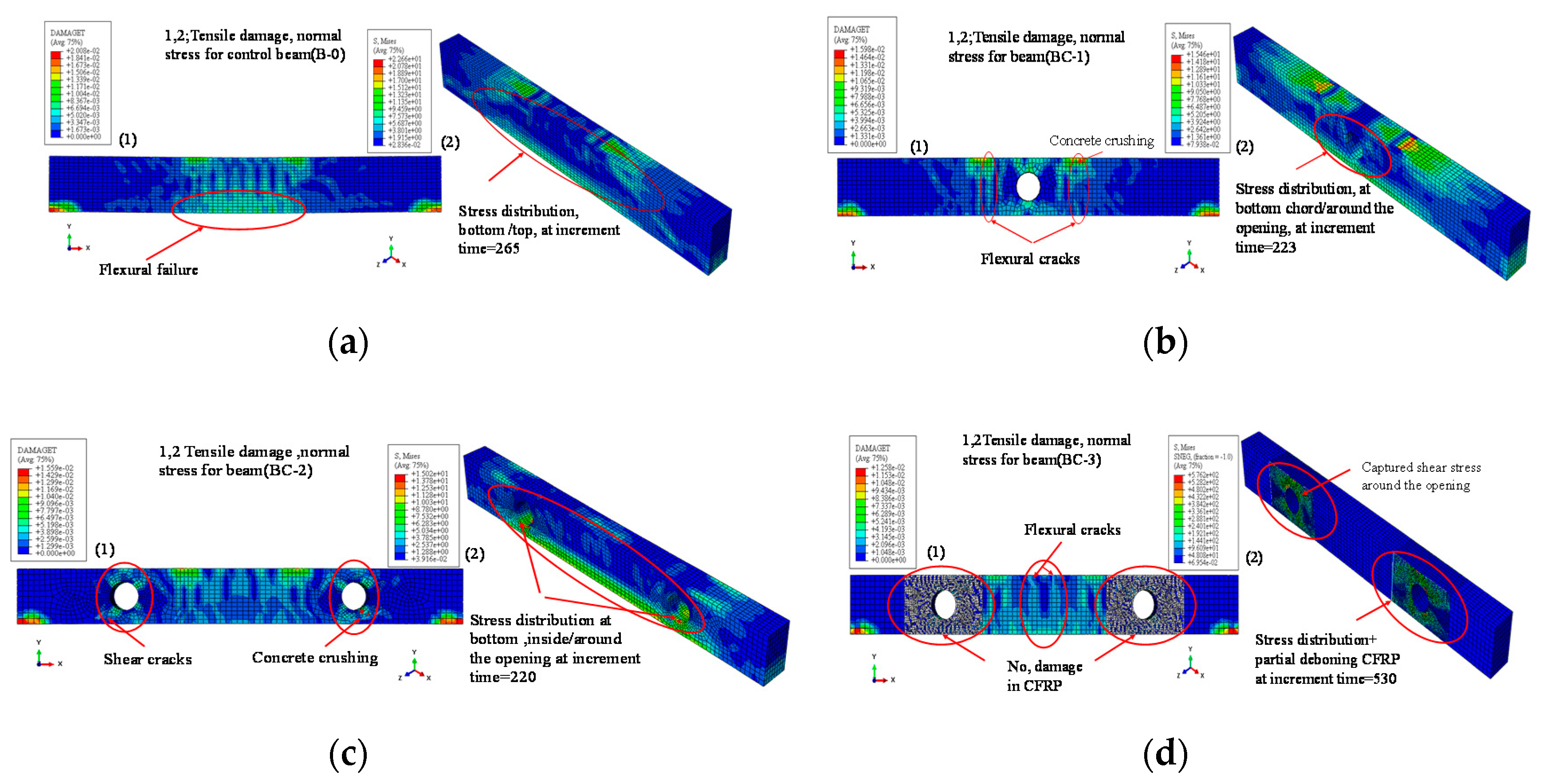
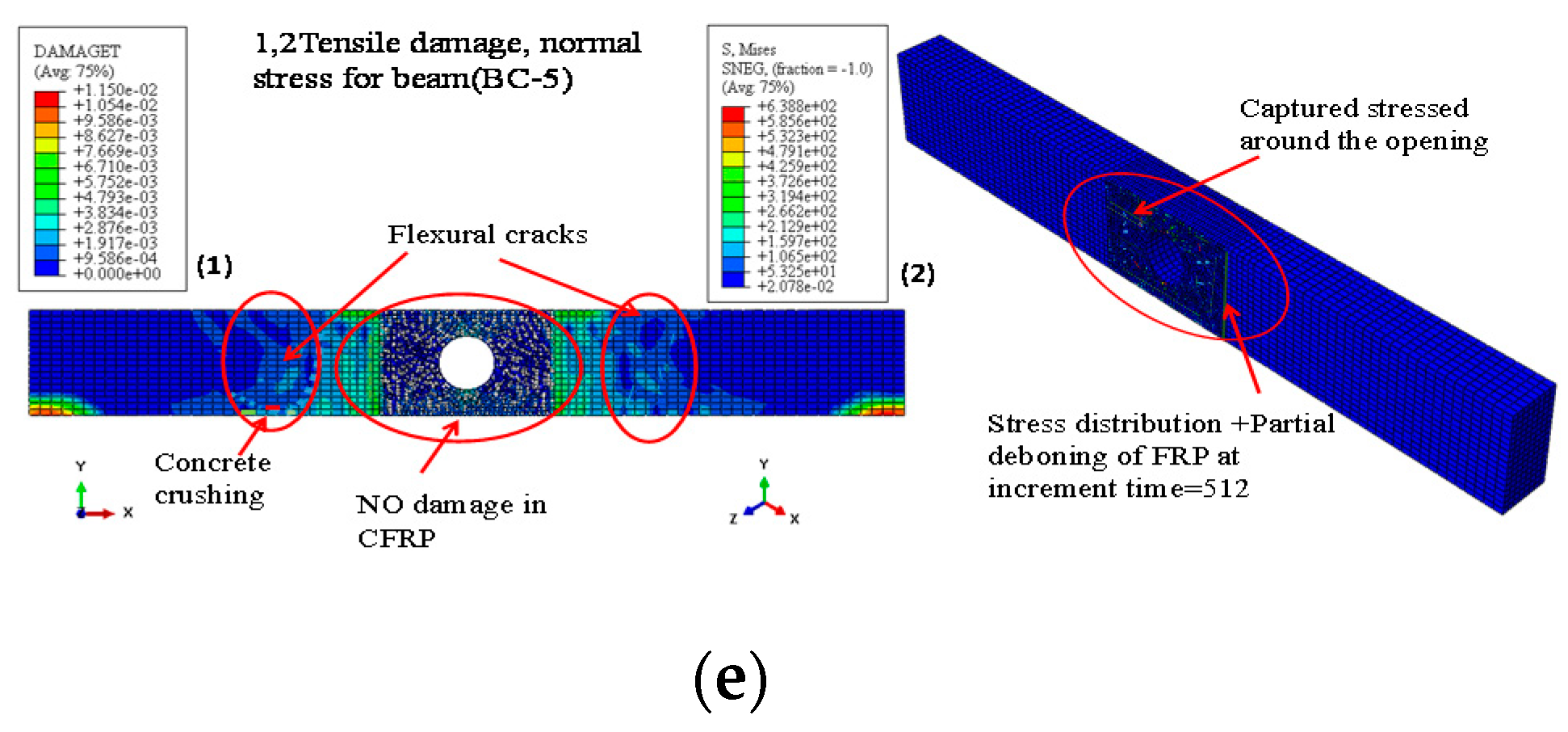
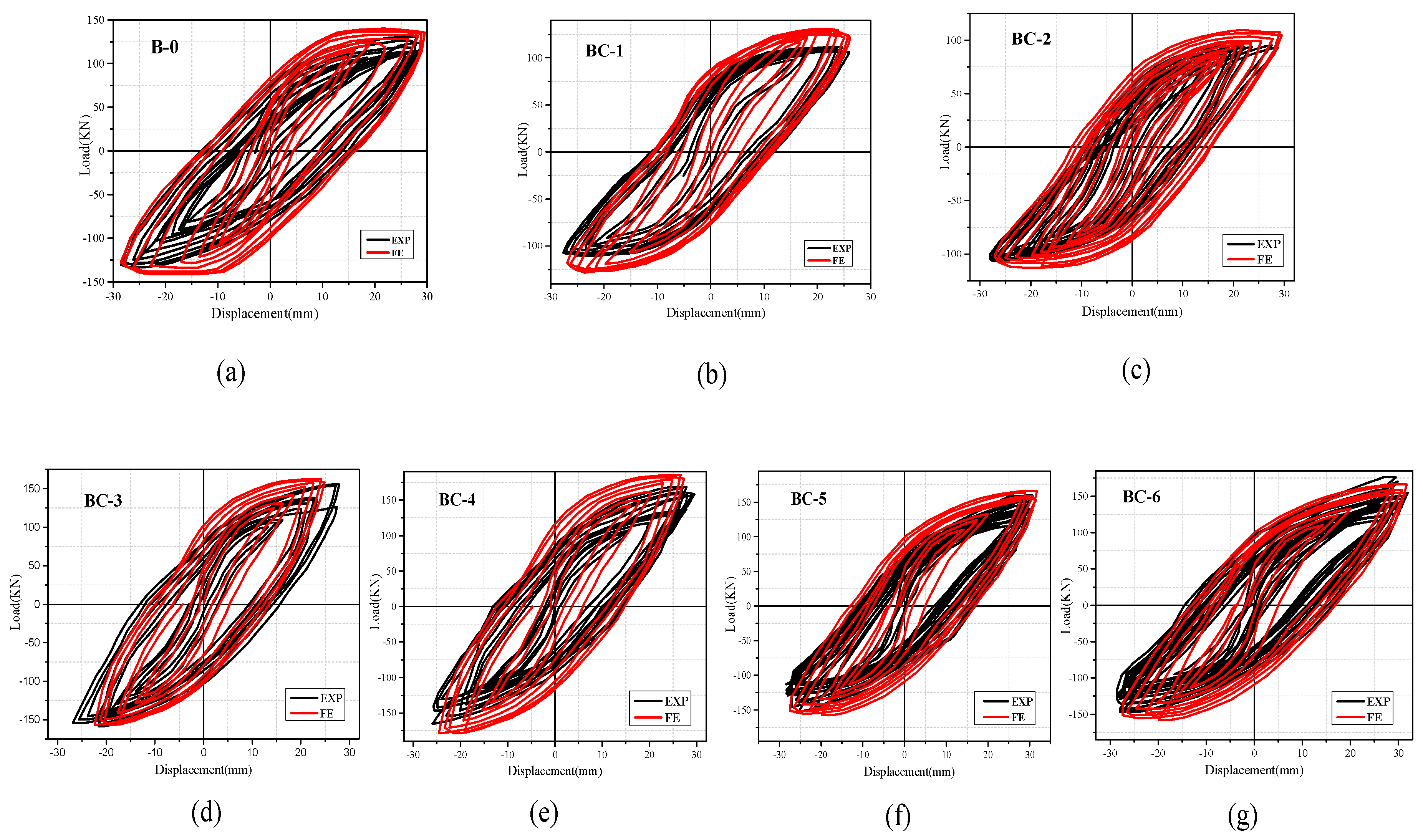
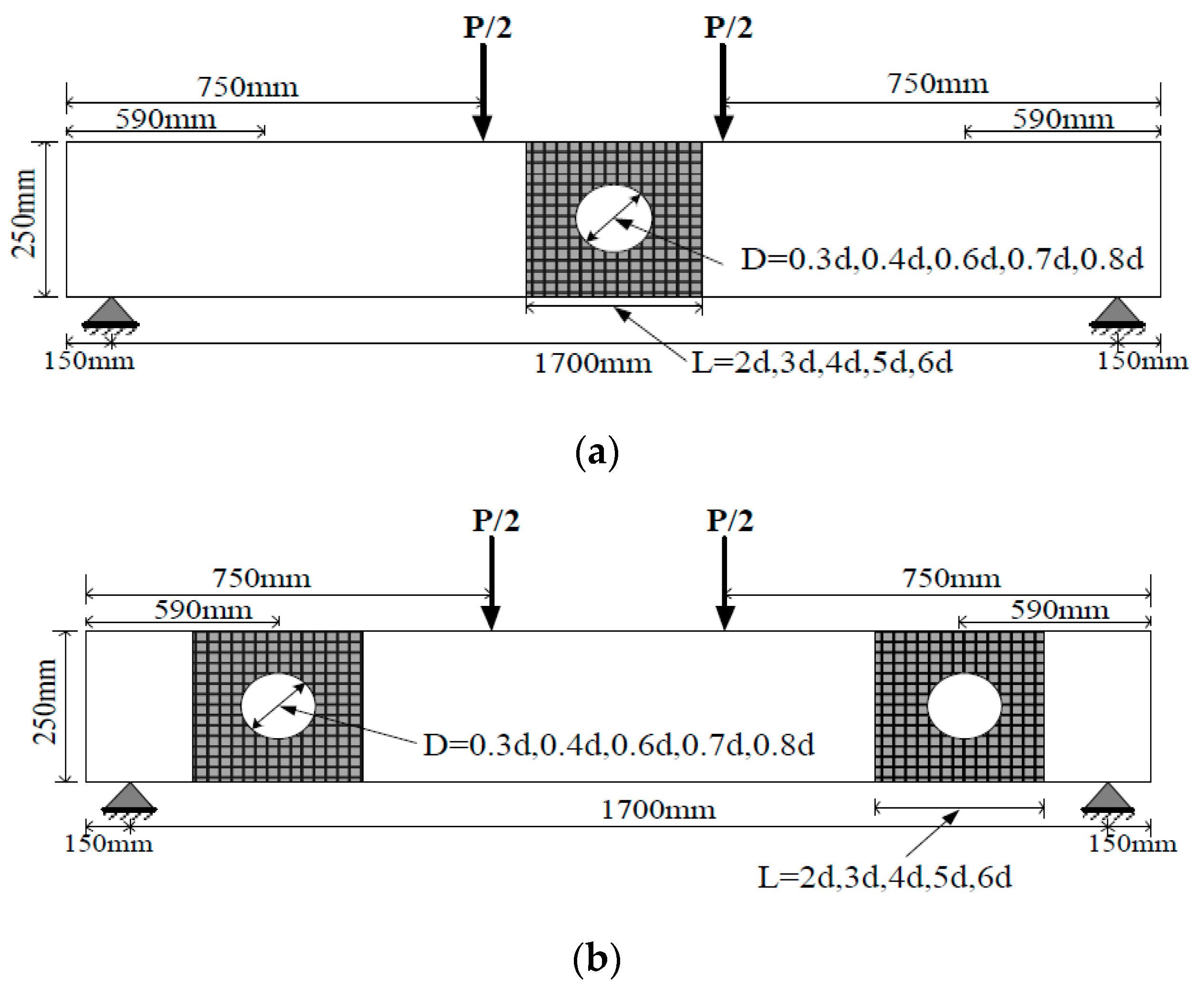
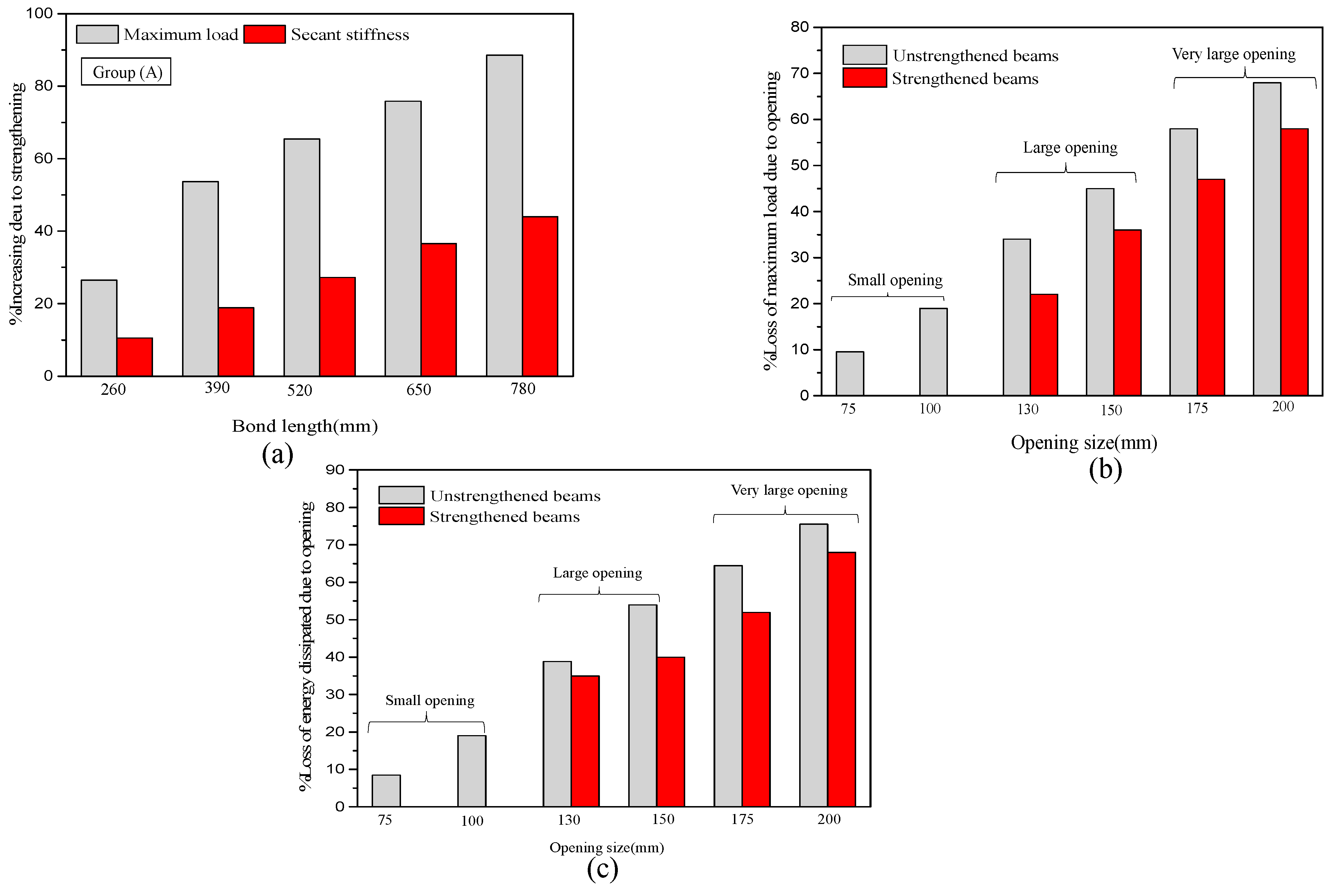
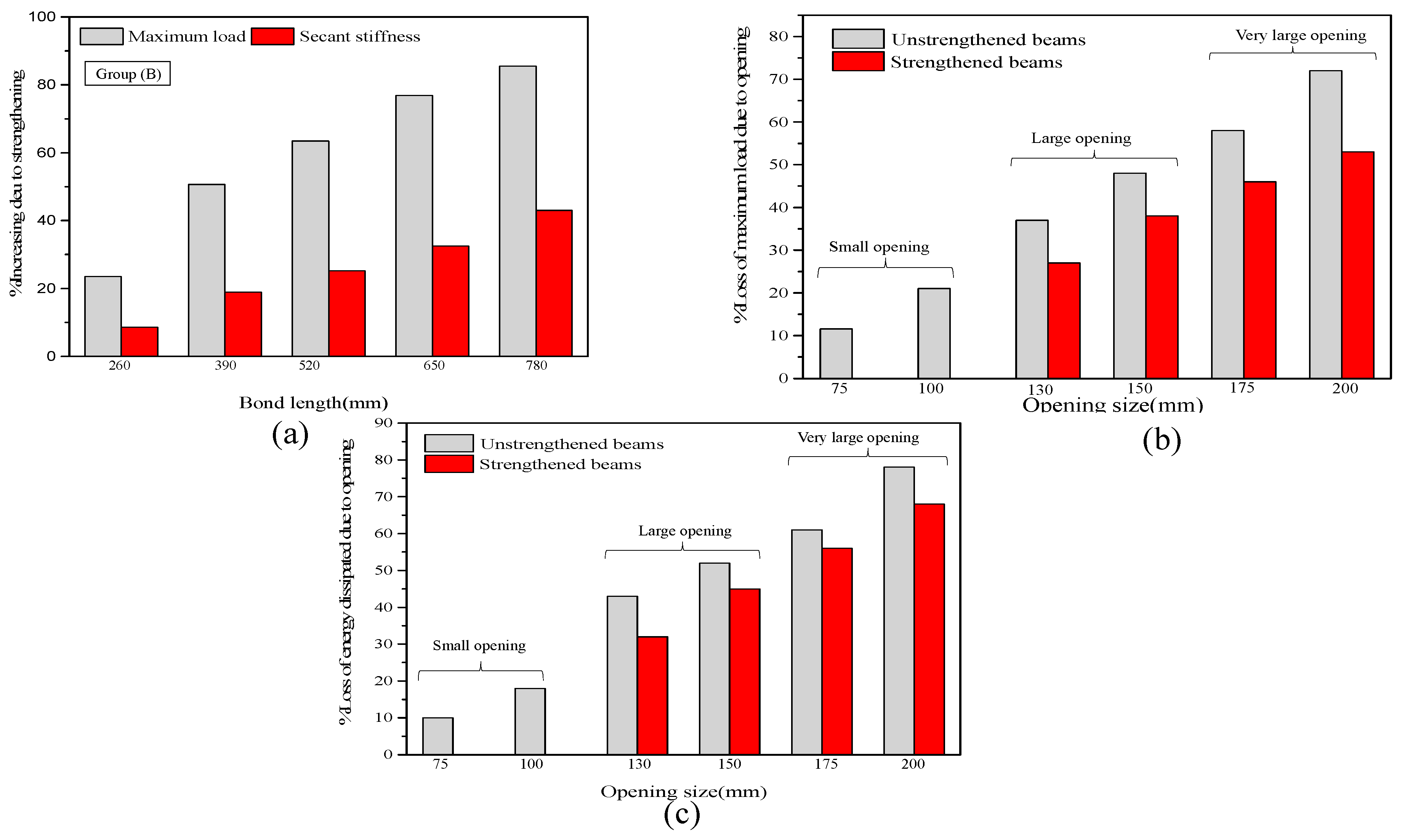
| Beam Name | Opening Size (mm) | FRP Schemes | FRP Organizing | Concrete Strength fc a (MPa) |
|---|---|---|---|---|
| B-0 | - | - | - | 30 |
| BC-1 | 130 | - | - | 30 |
| BC-2 | 130 | - | - | 30 |
| BC-3 | 130 | Vertical/Uwarp | 2 layers (0/90) | 30 |
| BC-4 | 130 | Inclined/Uwarp | 2 layers (60/120) | 30 |
| BC-5 | 130 | Vertical/Uwarp | 2 layers (0/90) | 30 |
| BC-6 | 130 | Inclined/Uwarp | 2 layers (60/120) | 30 |
| Grade | Grade | Diameter (Ø) | Yield Strength | Tensile Strength | Elongation |
|---|---|---|---|---|---|
| G.B 1 | B.S 2 | mm | MPa | MPa | % |
| HRB400 | 460 | 12 | 485.4 | 650 | 15 |
| HRB400 | 460 | 10 | 480.3 | 570.5 | 15 |
| HPB300 | 250 | 8 | 306.8 | 446.7 | 11 |
| Material | Tensile Strength (MPa) | Elastic Modulus (GPa) | Ultimate Strain (%) | Density (kg/m3) | Thickness (mm) |
|---|---|---|---|---|---|
| Carbon fiber | 3400 | 230 | ≥1.6 | 1.72 | 0.335 |
| CFSR-A * | 40 | 2.40 | ≥1.5 | - | - |
| CFSR-B * | 38 | 2.40 | ≥1.5 | - | - |
| Specimen | Cracking Load (KN) | Pult 1 (KN) | Ymax 2 (mm) | Pmax 3 (KN) | Disp-Max 4 (mm) | Duc-Ratio 5 (μ) | Stiff-Ki 6 (kN/mm) | Failure Mode |
|---|---|---|---|---|---|---|---|---|
| B-0 | 42.55 | 95.12 | 11.38 | 118.92 | 27.43 | 2.38 | 10.44 | Flexure |
| BC-1 | 38.75 | 79.07 | 10.53 | 98.84 | 25.78 | 2.16 | 9.28 | Shear |
| BC-2 | 34.25 | 75.53 | 10.44 | 94.41 | 23.52 | 2.13 | 9.04 | Flexure |
| BC-3 | 47.62 | 121.8 | 12.52 | 152.25 | 28.66 | 2.36 | 12.16 | Flexure |
| BC-4 | 54.44 | 129.98 | 12.96 | 162.48 | 30.85 | 2.38 | 12.54 | Flexure |
| BC-5 | 60.20 | 137.26 | 12.82 | 172.37 | 31.15 | 2.46 | 13.44 | Flexure-shear |
| BC-6 | 61.75 | 138.59 | 12.76 | 173.24 | 32 | 2.55 | 13.58 | Flexure-shear |
| EXP * | FE ** | Pmax 1 | Δmax 2 | Duc-Ratio | Stiff-Ki | PEXP |
|---|---|---|---|---|---|---|
| Specimen | model | (KN) | (mm) | (μ) | (kN/mm) | PFE |
| B-0 | M1 | 132.03 | 28.53 | 2.70 | 12.67 | 0.92 |
| BC-1 | M2 | 110.67 | 27.07 | 2.49 | 10.02 | 0.91 |
| BC-2 | M3 | 107.63 | 24.46 | 2.45 | 9.91 | 0.90 |
| BC-3 | M4 | 160.34 | 28.66 | 2.57 | 11.44 | 0.95 |
| BC-4 | M5 | 168.41 | 31.16 | 2.67 | 11.60 | 0.96 |
| BC-5 | M6 | 170.01 | 31.77 | 2.69 | 11.60 | 1.01 |
| BC-6 | M7 | 171.32 | 32.32 | 2.72 | 11.64 | 1.02 |
| Beam Name | Bond Length of FRP (mm) | FRP Orientation | Opening Size (mm) | FE Results | |||||
|---|---|---|---|---|---|---|---|---|---|
| Pmax h | Δ-max i | Y-max | Duc-Ratio | Stiff-Ki | Failure | ||||
| (KN) | (mm) | (mm) | (μ) | (KN/mm) | Mode | ||||
| Effect of FRP sheet parameters | |||||||||
| B1-1 a | 260 | Uwarp-2 layers * | 130 | 140.23 | 26.05 | 12.02 | 2.21 | 10.67 | Flexure |
| B1-2 a | 390 | Uwarp-2 layers * | 130 | 170.01 | 31.77 | 14.66 | 2.69 | 11.8 | Flexure |
| B1-3 a | 520 | Uwarp-2 layers * | 130 | 182.23 | 33.55 | 15.72 | 2.87 | 12.58 | Flexure |
| B1-4 a | 650 | Uwarp-2 layers * | 130 | 194.55 | 35.23 | 16.69 | 3.05 | 13.26 | Flexure |
| B1-5 a | 780 | Uwarp-2 layers * | 130 | 208.05 | 36.34 | 17.8 | 3.23 | 14.14 | Flexure |
| B2-1 b | 260 | Uwarp-2 layers * | 130 | 132.68 | 24.23 | 11.42 | 2.1 | 10.14 | Shear |
| B2-2 b | 390 | Uwarp-2 layers * | 130 | 160.34 | 28.66 | 14.02 | 2.57 | 11.44 | Y-sh ** |
| B2-3 b | 520 | Uwarp-2 layers * | 130 | 174.24 | 31.87 | 14.77 | 2.76 | 12.12 | Y-sh ** |
| B2-4 b | 650 | Uwarp-2 layers * | 130 | 188.57 | 33.82 | 15.86 | 2.93 | 12.84 | Flexure |
| B2-5 b | 780 | Uwarp-2 layers * | 130 | 200.15 | 34.28 | 16.91 | 3.07 | 13.57 | Flexure |
| Effect of opening diameter | |||||||||
| B-0 c | - | 0 | 132.03 | 28.53 | 12.67 | 2.79 | 11.51 | Flexure | |
| BUA-75 d | - | Un-strengthened | 75 | 126.74 | 28.01 | 12.55 | 2.67 | 10.54 | Flexure |
| BUA-100 d | - | Un-strengthened | 100 | 118.27 | 27.64 | 12.41 | 2.55 | 10.32 | Flexure |
| BUA-130 d | - | Un-strengthened | 130 | 110.67 | 27.07 | 11.05 | 2.49 | 10.02 | Flexure |
| BUB-75 e | - | Un-strengthened | 75 | 122.63 | 26.73 | 11.82 | 2.58 | 10.11 | Flexure |
| BUB-100 e | - | Un-strengthened | 100 | 113.63 | 25.31 | 11.01 | 2.49 | 10.01 | Flexure |
| BUB-130 e | - | Un-strengthened | 130 | 107.63 | 24.46 | 10.86 | 2.45 | 9.91 | Flexure |
| BUA-150 e | - | Un-strengthened | 150 | 92.47 | 23.01 | 9.23 | 2.03 | 8.27 | Y-sh ** |
| BSA-150 f | 780 | Uwarp-2 layers * | 150 | 155.8 | 29.23 | 13.48 | 2.47 | 10.67 | Y-sh ** |
| BUA-170 d | - | Un-strengthened | 170 | 75.21 | 19.33 | 7.62 | 1.66 | 6.71 | Y-sh ** |
| BSA-170 f | 780 | Uwarp-2 layers * | 170 | 143.59 | 26.89 | 12.4 | 2.27 | 9.82 | RP-at opening |
| BUA-200 d | - | Un-strengthened | 200 | 60.24 | 16.46 | 6.1 | 1.22 | 5.37 | SF-at opening |
| BSA-200f f | 780 | Uwarp-2 layers * | 200 | 128.39 | 23.2 | 11.01 | 1.89 | 8.22 | RP-at opening |
| BUB-150 e | - | Un-strengthened | 150 | 88.75 | 20.06 | 8.9 | 1.95 | 6.62 | Y-sh ** |
| BSB-150 g | 780 | Uwarp-2 layers * | 150 | 150.12 | 28.07 | 12.44 | 2.37 | 10.24 | Y-sh ** |
| BUB-170 e | - | Un-strengthened | 170 | 70.35 | 16.05 | 7.12 | 1.56 | 4.65 | SF-at opening + |
| BSB-170 g | 780 | Uwarp-2 layers * | 170 | 136.91 | 26.68 | 11.42 | 2.13 | 9.21 | RP-at opening = |
| BUB-200 e | - | Un-strengthened | 200 | 55.82 | 12.84 | 5.7 | 1.01 | 3.62 | SF-at opening + |
| BSB-200 g | 780 | Uwarp-2 layers * | 200 | 122.61 | 20.23 | 9.92 | 1.34 | 6.27 | RP-at opening + |
© 2020 by the authors. Licensee MDPI, Basel, Switzerland. This article is an open access article distributed under the terms and conditions of the Creative Commons Attribution (CC BY) license (http://creativecommons.org/licenses/by/4.0/).
Share and Cite
Salih, R.; Zhou, F.; Abbas, N.; Khan Mastoi, A. Experimental Investigation of Reinforced Concrete Beam with Openings Strengthened Using FRP Sheets under Cyclic Load. Materials 2020, 13, 3127. https://doi.org/10.3390/ma13143127
Salih R, Zhou F, Abbas N, Khan Mastoi A. Experimental Investigation of Reinforced Concrete Beam with Openings Strengthened Using FRP Sheets under Cyclic Load. Materials. 2020; 13(14):3127. https://doi.org/10.3390/ma13143127
Chicago/Turabian StyleSalih, Rania, Fangyuan Zhou, Nadeem Abbas, and Aamir Khan Mastoi. 2020. "Experimental Investigation of Reinforced Concrete Beam with Openings Strengthened Using FRP Sheets under Cyclic Load" Materials 13, no. 14: 3127. https://doi.org/10.3390/ma13143127
APA StyleSalih, R., Zhou, F., Abbas, N., & Khan Mastoi, A. (2020). Experimental Investigation of Reinforced Concrete Beam with Openings Strengthened Using FRP Sheets under Cyclic Load. Materials, 13(14), 3127. https://doi.org/10.3390/ma13143127





